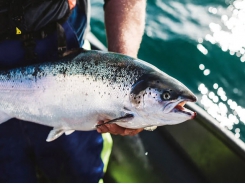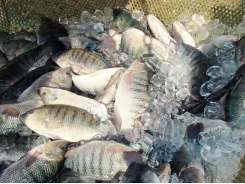Propolis extract may boost Nile tilapia survival in cold conditions

Supplementing Nile tilapia diets with propolis extract may improve fish survival and growth during cold stress conditions, say researchers.
An international team of researchers from the National Institute of Oceanography and Fisheries (NIOF), Benha University and Cairo University in Egypt along with the University of Arizona in the US explored the use of propolis extract in the feed of Nile tilapia. The group published its work in the journal, Aquaculture.
“The objectives of the current study aimed to verify to what extent the use of propolis-extract could mitigate winter thermal stress by improving the nutrition, hematological indices, blood biochemical indices and selected gene expression marker (Δ 9D) and survival of juvenile Nile tilapia,” the researchers said.
The researchers found that adding 4g kg-1 to the diets resulted in the best survival rate for the tilapia. Both weight gain (WG) and specific growth rate (SGW) improved linearly as more of the extract – also called “bee glue” – was added to the feeds.
The supplement also improved the feed conversion ratio and there was a positive response in hemoglobin, red blood cell count, white blood cell count, hematocrit, triglyceride, potassium and cholesterol as increasing levels of the extract were added to the diet, they said. However, aspartate aminotransferase, lactate dehydrogenase, alkaline phosphatase, serum cortisol and glucose declined as more of the extract was added to the diet.
The expression of the Δ 9D gene also was “upregulated” during the cold stress period as the amount of propolis extract increased, they said.
“The supplementation of 3 to 4 g kg−1 of propolis-extract in Nile tilapia diets could enhance fish resistance to cold temperature stress during winter season, decrease the mortality, and enhance the physiological status, thus showing a potential for use in aquatic feed industry as a feed additive in winter diets,” the researchers said. “But as this was the first study to address this issue, further studies are needed to clarify even more the propolis-extract's immunostimulatory and antioxidant beneficial properties and its effective supplementation in Nile tilapia winter diets.”
Cold stress challenge to aquaculture
Water temperature is an important consideration for fish production as it influences many physiological processes for fish, the researchers said. These include growth, metabolism and reproduction.
Fish can manage a range of temperature variations in traditional habitats, but “deleterious consequences” can occur when water temperatures surpass the species thermal tolerance zone, they said. Nile tilapia have become an important fish for warm water aquaculture, but it is sensitive to cold stress and winter cold fronts have caused mass mortality events.
Fish stop eating as temperatures dip below 20C and growth performance suffers, they said. Fish also are more prone to metabolic dysfunction, immunological disorders and infections.
High mortality rates from cold temperatures also can bring producers economic losses, the researchers said. “The tropical/subtropical origins of Nile tilapia are obviously reflected in their thermal preferendum as these fish do not grow well at temperatures below 16 °C and cannot survive for more than a few days below 10 °C,” they added.
However, to improve the yield of Nile tilapia juveniles moved to production ponds in the spring will not be market size by the end of the summer and will need to be managed through the winter, they said. Adding, “The ability to cope with cold stress in winter season is quite important for the survival of fish under farming condition.”
“Cold stress mitigation is up-regulated by the delta-9-desaturase (Δ 9D) which is widely expressed in many aquatic animals in the process of cold acclimation (Zerai et al., 2010),” the researchers said. “A major function of Δ 9D is to desaturate membrane lipids in order to sustain membrane fluidity during cold exposure (Polley et al., 2003; Murray et al., 2007).”
Why add propolis to tilapia diets?
There is little information and few technologies to support tilapia production in subtropical regions where water temperature may see high variation, the researchers said. Fish feed and functional additives may be a path to manage fish stress levels.
Previous methods that have been explored to support Nile tilapia for the winter season include covering ponds, increasing water depth and using biofloc technology, they said. Little work has addressed the nutritional approach to addressing cold stress.
In other fish species, seabream responded positively to a high-energy diet supplied prior to cold stress, while barramundi had better growth and metabolic responses during a cold period when fed a diet supplemented with polyunsaturated fatty acids, they said. Seabream had improved immune status following winter feeding of a diet with “vitamin C, vitamin E, choline, inositol, minerals, higher levels of highly unsaturated fatty acids and phospholipids.”
It has been suggested that cold stress could be managed using a diet designed to enhance fish immune defense mechanisms or by feeding diets with high levels of polyunsaturated fatty acids, they said.
Beehive products present one class of non-specific immunostimulants considered cost-effective and with little environmental effect, the researchers said. Propolis, or bee glue, mixes plant products and honeybee secretions to provide more than 200 bioactive compounds.
“Propolis is known to be active against (gram-positive) bacteria, viruses, fungi, parasites, oxidants, inflammation and serve as an immunomodulator,” they said. It also has been used to improve growth performance in Nile tilapia when added at 10g kg-1 and in rainbow trout at 2g and 4g kg-1
Feeding trial details
During the feeding trial, 675 tilapia received one of five diets for during a 60-day winter stress period, the researchers said. Diets were designed to be isonitrogenous (303.2g kg-1 crude protein) and isocaloric (19.44 MJ kg-1).
The pelleted diets included varying levels of propolis extract at 0, 1, 2, 3 or 4g kg-1 feed, they said. Water temperature during the trial was 16-19C (60.8-66.2F).
The propolis sample used to generate the extract was provided by the Honeybee project at Benha University.
Fish weight was measured every 2 two weeks to assess growth and feed conversion, mortality rates were noted, and water temperatures were monitored daily, the researchers said. Weight gain (WG), SGR, feed conversion (FCR), protein efficiency (PER) and feed intake were determined.
Blood samples were collected at the end of the trial to check for components including hematocrit (Htc), hemoglobin (Hb), serum aspartate aminotransferase (AST), alanine aminotransferase (ALT), serum cholesterol, triglycerides, low density lipoprotein-cholesterol (LDL-C), high density lipoprotein-cholesterol (HDL-C), glucose and cortisol levels, they said.
The expression of delta-9-desaturase gene was also examined, they said.
Result highlights
“The optimum dietary inclusion level of propolis was estimated at 4 g kg−1 based on the maximization of the growth parameters and survival rate,” the researchers said.
Throughout the trial, fish on the control diet had the lowest survival rate, while those receiving the diet with 4g of propolis extract had the highest survival rate, they said. Weight gain was higher for all fish on the supplemented diets compared to the control.
“Final body weight (FBW), weight gain (WG) and specific growth rate (SGR) were linearly improved with the increasing addition of dietary propolis-extract,” they said. “Dietary propolis-extract had a significant improving effect on feed intake (FI) and feed conversion ratio.”
There was a positive quadratic response for Htc, Hb, LDL-C, HDL-C and potassium along with red and white blood cell counts as the level of extract in the diet increased – the highest values were for fish on the 4g diet, they said.
ALT, AST, alkaline phosphatase and lactate dehydrogenase levels fell linearly, and serum cortisol and glucose fell quadratically as more of the extract was added to diets, the researchers said. However, triglycerides, sodium and cholesterol levels linearly increased.
Gene expression of delta-9-desaturase was upregulated linearly as supplement levels increased, they said.
Source: Aquaculture
Authors: M. Hassaan, A. EL Nagar, H. Salim, K. Fitzsimmons, E. El-Haroun
Related news
Tools

Phối trộn thức ăn chăn nuôi

Pha dung dịch thủy canh

Định mức cho tôm ăn

Phối trộn phân bón NPK

Xác định tỷ lệ tôm sống

Chuyển đổi đơn vị phân bón

Xác định công suất sục khí

Chuyển đổi đơn vị tôm

Tính diện tích nhà kính

Tính thể tích ao




 What’s salmon feed really made of?
What’s salmon feed really made of?  The fish feed that grows on trees
The fish feed that grows on trees